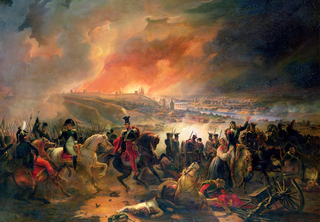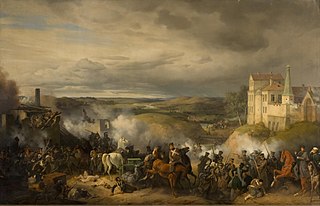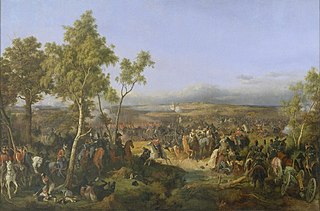
The Battle of Borodino took place near the village of Borodino on 7 September [O.S. 26 August] 1812 during Napoleon's invasion of Russia. The Grande Armée won the battle against the Imperial Russian Army, but failed to gain a decisive victory and suffered tremendous losses. Napoleon fought against General Mikhail Kutuzov, whom the Emperor Alexander I of Russia had appointed to replace Barclay de Tolly on 29 August [O.S. 17 August] 1812 after the Battle of Smolensk. After the Battle of Borodino, Napoleon remained on the battlefield with his army; the Imperial Russian forces retreated in an orderly fashion southwards. Because the Imperial Russian army had weakened the Grande Armée, they allowed the French occupation of Moscow, using scorched earth tactics on their own population to trap Napoleon and his men with their own largest city. The failure of the Grande Armée to completely destroy the Imperial Russian army, and in particular Napoleon's reluctance to deploy his Imperial Guard due to Napoleon's wishes to negotiate with Alexander to make him join against the British, has been widely criticised by historians as a large blunder, as it allowed the Imperial Russian army to continue its retreat into territory increasingly hostile to the French.

The Battle of Smolensk was the first major battle of the French invasion of Russia. It took place on 16–18 August 1812 and involved about 45,000 men of the Grande Armée under Emperor Napoleon I against about 30,000 Russian troops under General Barclay de Tolly. Napoleon occupied Smolensk by driving out Prince Pyotr Bagration's Second Army. The French artillery bombardment burned the city to the ground. Of 2,250 buildings, 84% were destroyed with only 350 surviving intact. Of the city's 15,000 inhabitants, about 1,000 were left at the end of the battle inside the smoking ruins. With over 15,000 casualties, it was one of the bloodiest battles of the invasion.

The Battle of Valutino took place on 19 August 1812, between a corps of French and allied troops led by Marshal Ney, about 35,000 strong, and a strong rear-guard of General Barclay de Tolly's Russian army of about 25,000, commanded by the general himself. The Russians were strongly posted in marshy ground, protected by a small stream, about 20 kilometers east of Smolensk. The French, attacking resolutely, captured the Russian position in the face of considerable physical obstacles.

The Battle of Maloyaroslavets took place on 24 October 1812 as part of the French invasion of Russia. It was Kutuzov's decisive battle to force Napoleon to retreat northwest over Mozhaisk to Smolensk on the devastated route of his advance with a higher probability of starvation. Kutuzov's next attack against the remnants of the Grande Armée, the Battle of Krasnoi, began on 15 November 1812, three weeks later.

The Battle of (the) Berezina took place from 26 to 29 November 1812, between Napoleon's Grande Armée and the Imperial Russian Army under Field Marshal Wittgenstein and Admiral Chichagov. Napoleon was retreating toward Poland in chaos after the aborted occupation of Moscow and trying to cross the Berezina River at Borisov. The outcome of the battle was inconclusive as, despite heavy losses, Napoleon managed to cross the river and continue his retreat with the surviving remnants of his army.

The Battle of Tarutino was a part of Napoleon's invasion of Russia. In the battle, Russian troops under the general command of Bennigsen, on instructions from Kutuzov, launched an attack and defeated French troops under the command of Joachim Murat. The battle is sometimes called the Battle of Vinkovo or the Battle of the Chernishnya after the local river. Many historians claim that the latter name is more fitting because the village of Tarutino was 8 km from the described events.

The Battle of Klyastitsy, also called the Battle of Yakubovo or the Battle of Oboiarszina, was a series of military engagements that took place on 30 July–1 August 1812 near the village of Klyastitsy on the road between Polotsk and Sebezh. In this battle, the Russian vanguard under the command of Yakov Kulnev and the whole corps of Peter Wittgenstein stood up to the French corps under the command of Marshal Nicolas Oudinot with heavy losses on both sides. The result was a Russian victory, their forces managing to capture the disputed village of Klyastitsy. The main strategic outcome of the battle was that the French offensive on St. Petersburg was stopped. The French partially retreated along their communication lines after the battle, and fended off Russian pursuers.

In the First Battle of Polotsk, which took place on 17–18 August 1812, Russian troops under the command of Peter Wittgenstein fought French and Bavarian troops led by Nicolas Oudinot near the city of Polotsk, halting Oudinot's advance toward Saint Petersburg. The First Battle of Polotsk should be distinguished from the Second Battle of Polotsk which took place during the same campaign two months later.

The Second Battle of Polotsk took place during Napoleon's invasion of Russia. In this encounter the Russians under General Peter Wittgenstein attacked and defeated a Franco-Bavarian force under Laurent Gouvion Saint-Cyr. In the aftermath of this success, the Russians took Polotsk and dismantled Napoleon's operations in Belarus. Wittgenstein's victory set the stage for the Battle of Berezina in November, in which three Russian armies converged on Napoleon from separate directions.

At the Battle of Smoliani, the Russians under General Peter Wittgenstein defeated the French forces of Marshal Claude Victor and Marshal Nicholas Oudinot. This battle was the last effort of the French to reestablish their northern flank in Russia, known as the "Dwina Line". Previously, the French had been defeated in this sector at the Second battle of Polotsk and at the Battle of Czasniki

The French invasion of Russia, also known as the Russian campaign, the Second Polish War, and in Russia as the Patriotic War of 1812, was initiated by Napoleon with the aim of compelling the Russian Empire to comply with the continental blockade of the United Kingdom. Widely studied, Napoleon's incursion into Russia stands as a focal point in military history, recognized as among the most devastating military endeavors globally. In a span of fewer than six months, the campaign exacted a staggering toll, claiming the lives of nearly a million soldiers and civilians.

The battle of Vitebsk, sometimes spelled Witepsk, was a military engagement that took place on 26 and 27 July 1812 during the French invasion of Russia. The battle put a French force, under the command of Emperor Napoleon I, in combat with Russian rearguard forces under General Petr Konovnitsyn and Peter von der Pahlen and ended with the Russian forces making a strategic retreat from the battlefield.

The Battle of Kobrin, or the Battle of Kobryn, took place on 27 July 1812 between the Russian and Saxon forces in the city of Kobrin (Kobryn) at the initial stage of the French invasion of Russia. The battle was a clear victory of the Russian forces.

The Battle of Gorodechno took place between an army of the Austrian and Saxon allies of Napoleonic France under the command of the Prince of Schwarzenberg and Russian troops under Alexander Tormasov at Gorodechno, a town in Kobrinsky Uyezd, Grodno Governorate. The battle was ultimately won by France's allies when Tormasov was forced to retire.

The Battle of Shevardino took place on 5 September 1812, between French and Russian troops, with a victory of the French army.

The First Battle of Krasnoi was fought on 14 August between Ney's French troops and Neverovsky's Russian troops. It ended with a victory for the French, but the Russians retreated in good order to Smolensk.

The Battle of Liaskowa took place 9 November 1812 near the village of Liaskowa, where 3,500 Cossacks under the command of Vasily Vasilyevich Orlov-Denisov surrounded 2,000 soldiers of the Grande Armée under Jean-Pierre Augereau.

The Battle of Wolkowisk (Volkovysk) took place 14–16 November 1812 near the village of Wolkowisk, where 35,000 Austrian, Saxon and French soldiers under Karl Philipp, Prince of Schwarzenberg defeated 27,000 Russian soldiers under Fabian Gottlieb von der Osten-Sacken.

The Battle of Borisov took place on 21 November 1812, between parts of the French army and parts of the Russian armies. The Russian army under Charles de Lambert defeated the French troops under Dombrowsky.

The Battle of Loschniza took place on 23 November 1812, between parts of the French army and parts of the Russian armies. The French army under Nicolas Oudinot defeated the Russian troops under Pavel Chichagov.






















